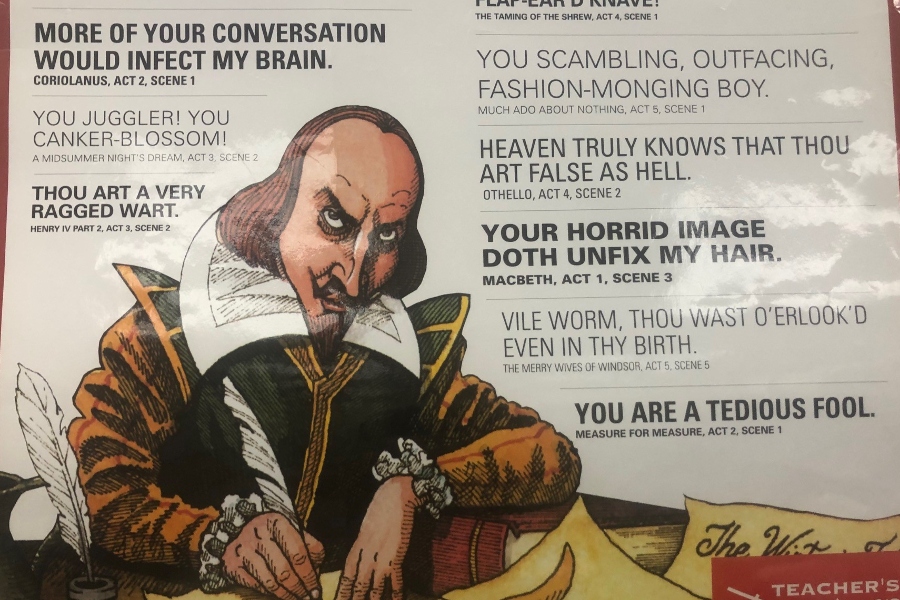Cancel the Bard
English teachers grapple with the value of teaching Shakespeare
Teachers are beginning to reconsider the value of teaching Shakespeare.
March 4, 2021
Shakespeare died in 1616, but he has been alive in high school classrooms for 500 years. Now there’s a growing movement to kill him.
More and more teachers think that Shakespeare shouldn’t be taught to young children, and some educators believe that Shakespeare should be “cancelled” for reason ranging from his works being as racist to sexist, containing “toxic masculinity”, and “whiteness” within the stories.
Throughout the United States there are a lot of schools that only teach white authors or play writers, using a cannon of works promoting only Western authors. That has created backlash. One article from the Toronto Sun, described a teacher from Hartford, Con, who, in a school that is 95% Black and Hispanic, is replacing Shakespeare with more diverse authors.
Bellwood-Antis doesn’t plan to eliminate the Bard from its curriculum but, it should do more to expose students to culturally diverse works of literature, English Department Chair Mr. Kerry Naylor said.
“When teachers choose to cover books with an entire class, they do so because it will help to improve reading skills and because it has universal qualities,” said Mr. Naylor, a ninth grade English teacher who teaches Romeo and Juliet and Hamlet each year. “Some teachers argue that Shakespeare is no longer universal, but I disagree. I think students from all walks of life can connect with the themes in his plays. In Romeo and Juliet alone you have young love, kids sneaking around behind their parents’ back, parents trying to control their kids lives and issues like depression and suicide. Those are ideas more important in the lives of the teens now than when Shakespeare wrote them.”
Mr. Naylor said connections with Shakespeare is also a lesson in empathy that should be a focus when reading any book.
“The whole point in reading any book is losing yourself in it for those hours, of making connections, feeling empathy. Shakespeare’s works are plays. The whole point to a movie or play is to suspend your disbelief for two hours and lose yourself in the characters. I’ve never been a prince and my dad wasn’t murdered by my uncle, but because of his issues with self-doubt and depression I can connect with Hamlet.”
However, Christopher Patrick, a teacher from nearby Huntingdon Area high School, says otherwise. He believes that Shakespeare may not be as relevant as people think, and his plays lack diversity.
” This may be unpopular, but I really think we could eliminate things like Shakespeare, Dickens, and some of the older, stuffy literature and expose our students to more modern things that weren’t all written by dead white guys,” Patrick said. “I think we should look at whether we’re teaching these things because ‘we’ve always done it’ or if there is a true value. I think our students need to be exposed to some of these writings, but I don’t believe that reading a Shakespeare play every year in high school is necessary when there is so much more out there for our students to read.”
At Bellwood-Antis Shakespeare is taught all 4 years. Romeo and Juliet is taught in 9th grade, Julius Caesar in 10th grade, Merchant of Venice in 11th grade, and Hamlet and Macbeth in 12th grade.
Aside from Mr. Naylor, other teachers from BA see the value in teaching Shakespeare but do their best to encourage diversity in other ways.
Mrs. Carol Bartlett, an 10th and 11th grade English teacher at BA, teaches The Merchant of Venice, “Sonnet 18; “Shall I compare Thee to a Summer’s Day”; and Julius Caesar. “In The Merchant of Venice, for example, (Shakespeare) deals with the topic of prejudice, and in “Sonnet 18” he deals with the topic of love; in Julius Caesar he deals with the topics ambition for power and murder. His works are a historical view of some aspects of human nature that never change.”
Mr. Tim Van Scoyoc, another English teacher at BA, teaches teaches his students Macbeth, Hamlet, and Othello, and he generally agrees with Mrs. Bartlett’s assessment of Shakespeare’s value.
“While the issue of dealing with 400-year-old language can be a challenge, Shakespeare characters and situations still have relevance for modern audiences, and I believe that students do find his plays interesting,” he said.
In order to address diversity, Mrs. Bartlett uses a website called commonlit.org to give her students more of a variety. On the other hand, Mr. Van Scoyoc teaches British literature, so he doesn’t much of a choice of diversifying his works.
The fault, Mr. Naylor said, is not in the teaching of Shakespeare but the general lack of diversity in American English classrooms.
“We all- myself included as the BA English chair- need to do a better job of including works from diverse author in our curriculum,” he said. “Almost every author we read as a part of English literature cannon is by a male European writer, and the not so subtle message becomes these are the greatest writers ever. Well, when there’s no representation of black writers, Latino writers, female writers and so on, the other not so subtle message is those ethnic and cultural groups have not contributed great writers and great works to our literacy experience, and nothing could be further from the truth.”






